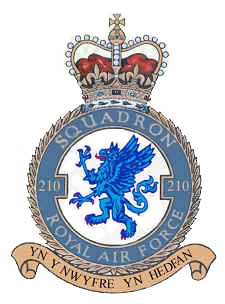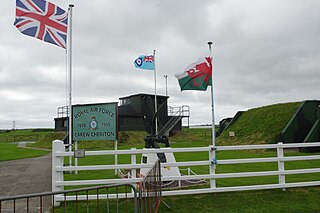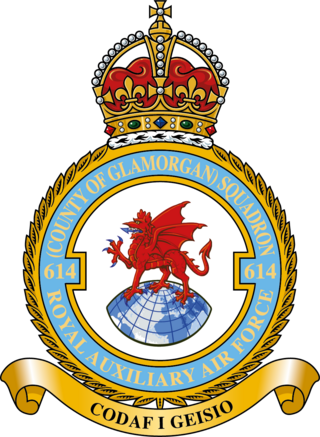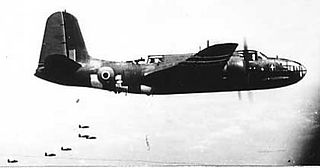
Number 230 Squadron Royal Air Force is a Royal Air Force (RAF) flying squadron, currently based at Medicina Lines in Brunei Darussalam, part of British Forces Brunei, operating the Westland Puma HC2. The squadron was previously part of Royal Air Force Germany (RAFG), operating the Puma HC1 there from 1980. Following the drawdown of the British Armed Forces in Germany at the end of the Cold War, the squadron disbanded on 30 April 1992. This was short-lived however, and the squadron reformed at RAF Aldergrove on 4 May 1992, again with the Puma HC1.
No. 119 Squadron RAF was a squadron of the Royal Air Force, flying with RAF Coastal Command during the Second World War. It was the only RAF unit flying the Short G class and Short C class flying boats.
The No. 341 Squadron also known in French as Groupe de Chasse n° 3/2 "Alsace", was a Free French squadron in the RAF during World War II.

No. 461 Squadron was a Royal Australian Air Force maritime patrol squadron during World War II which operated under Royal Air Force control flying in Europe and over the Atlantic. The squadron was formed in 1942 and was disbanded in mid-1945, just after the end of the war in Europe. Personnel were drawn from many countries of the British Empire, although the majority were Australians. Throughout the war, the squadron was credited with destroying a total of six German U-boats, and operated mainly in the Bay of Biscay and Atlantic.
The Netherlands Naval Aviation Service is the naval aviation branch of the Royal Netherlands Navy.

No. 504 Squadron was one of the Special Reserve Squadrons of the Auxiliary Air Force, and today is a reserve force of the RAF Regiment. It was integrated into the AAF proper in 1936. Based at RAF Cottesmore, Rutland, 504 Squadron used a variety of light bombers before being re-tasked to fighters with the Hawker Hurricane in 1939. It subsequently became a Fighter Squadron. Currently No. 504 Squadron no longer has a flying role, but as part of No 85 Expeditionary Logistics Wing of the RAF A4 Force.
No. 191 Squadron was a Royal Air Force squadron. During World War I it was a non-operational night training unit, while during World War II it was engaged in maritime reconnaissance.
No. 246 Squadron RAF was a squadron of the Royal Air Force.
No. 652 Squadron RAF was a unit of the Royal Air Force during the Second World War and afterwards in Germany. Numbers 651 to 663 Squadrons of the RAF were air observation post units working closely with Army units in artillery spotting and liaison. A further three of these squadrons, 664, 665 and 666, were AOP units of the Royal Canadian Air Force manned by Canadian and British personnel. Their duties and squadron numbers were transferred to the Army with the formation of the Army Air Corps on 1 September 1957.

No. 322 (Dutch) Squadron of the Royal Air Force was a fighter squadron during the Second World War.

No. 210 Squadron was a Royal Air Force unit established in the First World War. Disbanded and reformed a number of times in the ensuing years, it operated as a fighter squadron during the First World War and as a maritime patrol squadron during the Spanish Civil War, the Second World War and the Cold War before it was last deactivated in 1971.
No. 228 Squadron RAF was a squadron of the Royal Air Force active at various times between 1918 and 1964. It spent the greatest part of its existence flying over water, doing so in the First, and Second World Wars and beyond, performing anti-submarine, reconnaissance and air-sea rescue tasks.
No. 663 Squadron was an air observation post (AOP) unit, manned with Polish Army personnel, which was officially formed in Italy on 14 August 1944. Numbers 651 to 663 Squadrons were air observation post units working closely with Army units in artillery spotting and liaison. A further three of these squadrons, 664–666, were manned with Canadian personnel. Their duties and squadron numbers were transferred to the Army with the formation of the Army Air Corps on 1 September 1957.

Number 209 Squadron of the British Royal Air Force was originally formed from a nucleus of "Naval Eight" on 1 February 1917 at Saint-Pol-sur-Mer, France, as No. 9 Squadron Royal Naval Air Service (RNAS) and saw active service in both World Wars, the Korean War and in Malaya. The use of the squadron number ceased in 1968 and it has not been reused since by an RAF squadron. However the number, badge and motto is in current service within the RAF Air Cadets at 209 Squadron ATC in Nottinghamshire.

Royal Air Force Carew Cheriton, or more simply RAF Carew Cheriton, is a former Royal Air Force station located near Carew, Pembrokeshire. It was situated 4.7 miles (7.6 km) north west of Tenby.

No. 320 (Netherlands) Squadron RAF was a unit of the Royal Air Force during World War II formed from the personnel of the Royal Netherlands Naval Air Service.
No. 624 Squadron RAF was at first a special duties squadron of the Royal Air Force during World War II. It was later in the war tasked with mine-spotting, until disbanded at the end of the war.

No. 614 Squadron was originally formed on 1 June 1937 as an army co-operation squadron unit of the Auxiliary Air Force. It served during the Second World War first in this role and later as a bomber squadron. Upon reformation it served as a fighter squadron until the disbandment of the Royal Auxiliary Air Force on 10 March 1957.

The No. 342 Squadron also known in French as ''Groupe de Bombardement n° 1/20 "Lorraine", was a Free French squadron in the RAF during World War II.

Royal Air Force Pembroke Dock, or more simply RAF Pembroke Dock, was a Royal Air Force Seaplane and Flying boat station located at Pembroke Dock, Pembrokeshire, Wales. The Royal Navy contingent left in 1926 with the Royal Air Force occupying the site from 1 January 1930. During the initial stages of the Second World War, it became the home of two Dutch flying boats and their squadron personnel as well as hosting RAF, Fleet Air Arm, Royal Canadian Air Force, Royal Australian Air Force and United States naval aircrews.











